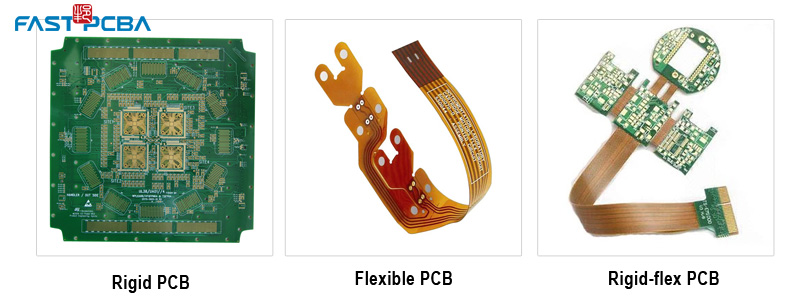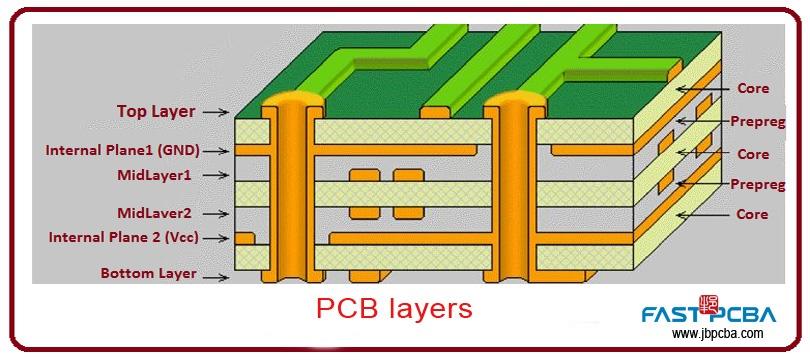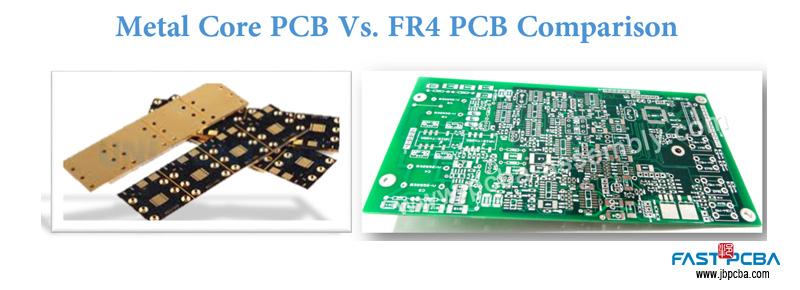About us
FASTPCBA Co.,Ltd
-
 Building 1, Senyang Electronic Technology Park, Guangming High-tech Park, Yutang Street, Guangming District, Shenzhen City.
Building 1, Senyang Electronic Technology Park, Guangming High-tech Park, Yutang Street, Guangming District, Shenzhen City.
-
 F:86-13418481618
F:86-13418481618
-
 [email protected]
[email protected]
 date:2020-11-02 16:23:03
date:2020-11-02 16:23:03
Printed circuit boards (PCB) are widely used in various equipment in industries such as automobiles, telecommunications, aerospace, military, and healthcare. Therefore, PCB manufacturing and supply are based on the purpose of various applications. These printed circuit boards (PCBs) can be distinguished according to various parameters. FASTPCBA provides an introduction to distinguishing different types of printed circuit boards (PCBs) through different parameters.
Understand the different types of PCB, circuit boards can be distinguished in different ways, but the following categories are more common:
1. Classification based on substrate: According to the use of substrate, printed circuit boards (PCB) are divided into Rigid PCB, Flexible PCB and Rigid-flex PCB.
2. Classification based on layers: According to the number of layers, printed circuit boards are divided into single-layer/single-sided PCB, double-layer/double-sided PCB and multilayer PCB.
3. Classification based on materials: According to the materials used for construction, PCBs can be divided into FR4 PCBs and metal core PCBs.
1.1. Overview of different types of PCBs based on substrates
Substrate-based characterization mainly focuses on three types of printed circuit boards (PCB), as described below:

Rigid PCB: Rigid PCB is manufactured using a solid material substrate. This strong substrate prevents Rigid PCB from twisting or bending. These are probably the most common and most manufactured PCBs. The number of layers is not a limitation of the printed circuit board, it can be a single layer or 10 layers. Glass fiber is a common manufacturing material used to manufacture rigid PCBs. It provides security benefits because it prevents twisting, so the installed components can be kept in place. Computer motherboards are the most common example of such PCBs.
Flexible PCB: Unlike Rigid PCB, Flexible PCB is made of flexible substrates, hence the name. It can be made into single layer, double layer or multilayer, and has a flexible backing. The biggest advantage of these Flexible PCBs is flexibility. It can be wrapped or folded according to the convenience of the application. These PCBs are made of flexible substrates, which are waterproof, corrosion resistant and temperature efficient. They are ideal for applications requiring high bend and flexibility. Over the years, Flexible PCB has gained tremendous popularity due to its flexible characteristics and compatibility with any type of components or connectors. The most common applications of Flexible PCB are in portable electronic devices, desktop printers, hard drives, etc.
Rigid-flex PCB: Rigid-flex PCB is a combination of the above types of PCB. These circuit boards are made by laminating flexible conductive layers on Rigid PCB. The advantage of this type of PCB is that it provides a simplified design and reduces the weight and size of the PCB. Like Flexible PCBs, these Rigid-flex PCBs can also withstand high temperatures and harsh working environments. The common applications of these Rigid-flex PCBs are digital cameras, automobiles, mobile phones, pacemakers, etc.
According to the design, structure, materials, etc. of the printed circuit board, the printed circuit board is cited in different ways. The above focuses on different types of printed circuit boards based on substrates.
2.1 The next focus is on layer-based and material-based PCBs. These two are important categories of PCBs, because most application-oriented PCB manufacturing involves these types.
What are the different types of layer-based PCBs?
The layer-based distinction takes into account the number of layers on the PCB. The combination of the conductor film and the prepreg can form a laminate/chapter, and the number of laminates can form a book. Therefore, the number of chapters or layers in the PCB determines the type of layer-based PCB.

Single-layer or single-sided PCB: Single-layer PCB is made of only one layer of material substrate. The layer of substrate or core material is coated with a thin film of conductive material. Generally, the conductive layer is a copper (Cu) film. Finally, a silk screen is applied to the copper layer to mark the components on the board. This is the simplest form of PCB and is usually used for DIY applications and prototypes. Common applications for single-layer PCBs are in radio equipment, LEDs, etc.
Double-layer or double-sided printed circuit boards: Double-layer printed circuit boards are made by laminating the laminate material of the substrate with a conductive material. Drill holes on each layer to achieve through-hole PCB assembly. Thin wires called leads are passed through the holes and then soldered to the appropriate components. It has the advantage of connecting circuits or components in two ways: surface mount or through-hole connection. Although wiring is not required in surface mounting, the double-layer board itself serves as the wiring surface for the component. Common applications for double-layer PCBs are vending machines, lighting systems, car dashboards and amplifiers.
Multilayer PCB: Multilayer PCB is a further development of double layer PCB. Similar to a double-layer PCB, multiple layers are added on both sides of the core. This allows PCB designers and manufacturers to develop complex and thick PCBs. The advantage of a multilayer PCB is that there is less electromagnetic interference and can provide equivalent power distribution. This will minimize the damage to the connection cable. These PCBs are used in complex devices such as computers, heart monitors, interactive displays, automobiles, etc.
3.1 Overview of different types of PCBs based on materials
According to the requirements at the end of the application, PCBs are developed with different material compositions. The following are the types of printed circuit boards classified by material.

Metal core PCB: The material substrate used in these metal core PCBs is aluminum, copper and steel alloys. For various purposes (such as good heat dissipation), aluminum is used as a steel alloy with low thermal conductivity. These PCBs can be made with any number of layers based on the form of the substrate. Metal core PCBs are widely used in LED systems and modern electronic products.
FR4 PCB: FR4 PCB is suitable for applications where fire resistance is important. In FR4, the term FR means flame retardant, and 4 means woven glass fiber with epoxy resin. These PCBs are made of fiberglass and epoxy, making them self-igniting. Due to its multiple economic and mechanical advantages, this is the most common type of PCB used today.
Both FR4 and metal core PCB can be designed as single-layer, double-layer or multilayer PCB or rigid-flex PCB according to application requirements. Since the types of printed circuit boards have been well introduced, it is important to choose a manufacturer or supplier wisely.
 Building 1, Senyang Electronic Technology Park, Guangming High-tech Park, Yutang Street, Guangming District, Shenzhen City.
Building 1, Senyang Electronic Technology Park, Guangming High-tech Park, Yutang Street, Guangming District, Shenzhen City.
 F:86-13418481618
F:86-13418481618
 [email protected]
[email protected]